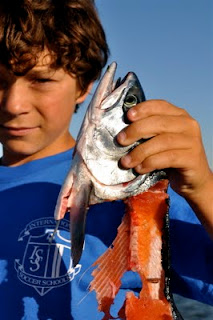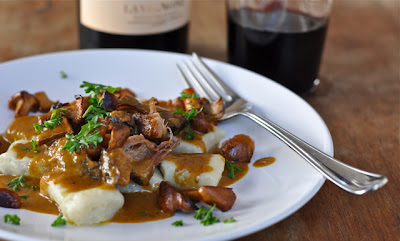Recently I had the pleasure of hanging out with a couple mad scientists of the kitchen in Washington’s San Juan Islands. Eric (besides being an ’80s pop aficionado and rapper-in-training) is a sous chef at Blueacre Seafood in Seattle and Scott is a software developer by day and the proprietor of the restlessly inventive Seattle Food Geek blog the rest of the time. It was my job to supply these two gastronomic alchemists with foraged wild foods so they could do their culinary magic.
If you’re a regular reader, you know I’m mostly about comfort food, the kind you can make in your own kitchen without an arsenal of specialized tools and exotic ingredients. I don’t pretend to be a trained chef or a molecular gastronaut. But I like to eat, and I’m open to all forms of eating. On Lopez Island Eric turned me on to a soup he likes to call High Tide because it evokes the sea with all its shifting flotsam and jetsam.

Despite the “high concept” appearance, this dish is right in my wheelhouse. First of all, it takes the principles of nose to tail eating, which we generally associate with landed livestock, to the oceans, where most of our prey is still wild yet diminishing. The backbone of the soup, so to speak, is the backbone of a salmon, the sort of leftover piece that usually gets chucked in the trash if not used for crab bait. Not in my house. It was the backbone of a silver salmon that supplied the meat for the risotto Hank Shaw made at my house, and my Salmon Head Soup distinguished itself enough to be included in the Foodista Best of Food Blogs Cookbook.
This time around the salmon was a pink, or humpy, as it’s also known, and its backbone was the key ingredient in a satisfyingly complex salmon broth. A quick word on pinks: at one time, when the rivers of the Northwest teemed with salmon, the pink was reviled in comparison to its more toothsome cousins, the chinook, sockeye, and silver. Now it’s the most plentiful wild salmon species in Puget Sound and demands our gustatory attention. Though not as versatile as its fattier relatives, pinks are still worthy with the right preparation.
The “meat” of the soup was entirely vegetarian—and terrestrial at that. Looking like weird sea creatures washed in by the tide, the leek bottoms and carrot tops, like the salmon backbone, are the sort of things that usually get tossed away. Shaved red cabbage completed the picture. I butter-poached these vegetables in clarified butter for a good 20 minutes or so, until the carrots were tender and the leeks and cabbage slightly caramelized with hints of brown.
It’s impossible to overstate how impressed I was by this soup. The tidal broth was a hit of umami—not too fishy, with an earthy balance of leek flavor—while the sea creatures within absolutely bursted with flavor from the butter-poaching. The carrots tasted like the best sort of stewed carrot and the leek bottoms had a toastiness that was almost as unexpected as the chewy texture of the tentacles…err…roots.
This will be a dish that I serve at the next dinner party.
The Tide
2 small to medium salmon backbones (or 1 large)
1 onion, chopped
2 carrots, diced
2 celery ribs, diced
1 tbsp olive oil
3 leeks, just green tops, chopped
1 handful parsley, chopped
1 quart water
salt and pepper, to taste
Saute the onion, carrot, and celery in olive oil until softened. Add water and heat to a low simmer. Add the salmon backbones, leeks, and parsley. Do not allow to boil. Cook at least 2 hours. Adjust seasoning. Strain soup through colander and again through fine mesh and cheesecloth, until clear. Return to pot. Add thinly sliced rounds of leek bulb and keep warm until ready to serve. Cooking the broth at low heat will prevent it from being too fishy, while the leeks—both the green tops and white slices—will balance the flavor, amplifying the wonderfully comfortable umami.
The Sea Creatures
1 stick butter
3 leek bottoms, with roots, rinsed
4-5 carrot tops, with green nub
1 handful shaved red cabbage
Clarify the butter, then in a small sauce pan butter-poach the leek bottoms, carrot tops, and red cabbage for 20 minutes or so, until the cabbage is starting to brown at the edges and the carrots and leeks are tender. Use tongs to turn the vegetables periodically.
Plate the butter-poached vegetables in bowls and ladle broth. Serves 2.
This was just one of 10 courses that Eric prepared with Scott’s help in the islands. I’ll be posting more on this extraordinary feast in the future, when the video treatment is edited.
Like this:
Like Loading...
 THE FIRST CHANTERELLES of the season are always my favorite. They’re firm and flavorful, without the large, tattered caps that are typical later in the season after multiple rain soakings.
THE FIRST CHANTERELLES of the season are always my favorite. They’re firm and flavorful, without the large, tattered caps that are typical later in the season after multiple rain soakings.











